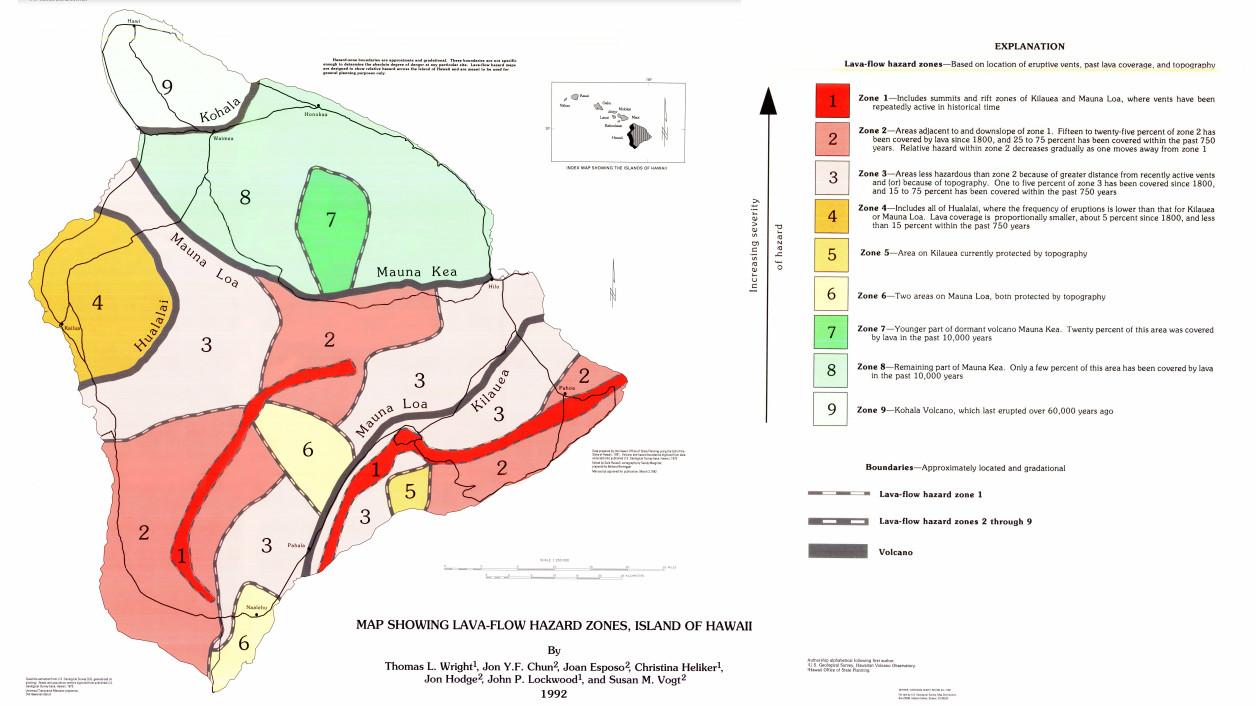(BIVN) – A State Senate resolution asking federal officials to update the lava-flow hazard map of Hawaiʻi island is advancing at the Capitol.
SCR3 SD1 urges the United States Geological Survey “to conduct topographical surveys, particularly within lava-flow hazard Zones 1 and 2, to update its long-term lava-flow hazard map of Hawaii island.”
State Senator Joy San Buenaventura (Puna) was among the introducers of the resolution. The House Committee on Water and Land recommended the measure be passed on Thursday.
The committee noted that the USGS lava-flow hazard map was prepared in 1974 and updated in 1992. It has not ben updated since.
House Committee on Water and Land meeting, via State House on YouTube
From the language of SCR3 SD1:
URGING THE UNITED STATES GEOLOGICAL SURVEY TO CONDUCT TOPOGRAPHICAL SURVEYS, PARTICULARLY WITHIN LAVA-FLOW HAZARD ZONES 1 AND 2, TO UPDATE ITS LONG-TERM LAVA-FLOW HAZARD MAP OF HAWAII ISLAND.
WHEREAS, for emergency management purposes, a hazard is an event or condition of the physical environment that results or may likely result in damage to property; injury to or death of individuals; or damage to the environment; and
WHEREAS, active volcanos are natural hazards that can repeatedly threaten public safety; and
WHEREAS, the tephra, ashfall, lahars, volcanic gas, lava flows, pyroclastic density currents, and volcanic landslides from a volcanic eruption can not only lead to an immediate loss of life and property, but also negatively alter the nearby environment for years to come; and
WHEREAS, there are six volcanoes that are classified as active in the State: Kilauea, Mauna Loa, Hualalai, and Mauna Kea on Hawaii island; Haleakala on the east side of Maui; and Kamaehuakamaloa, an underwater volcano within state waters southeast of Hawaii island; and
WHEREAS, in 1974, the United States Geological Survey (USGS) prepared a map of Hawaii island showing long-term lava-flow hazards based on existing geologic data. This map was updated in 1992 and published as “USGS Miscellaneous Field Studies Map 2193” and is still used today; and
WHEREAS, USGS Miscellaneous Field Studies Map 2193 divides Hawaii island into nine lava-flow hazard zones that are numerically ranked on a scale of decreasing hazard as the numbers increase; for example, Zone 1 is at highest risk and includes the summits and rift zones of active volcanoes where volcanic vents have been repeatedly active in historic time, and Zone 2 includes areas adjacent to and encompassing the downslope of active rift zones; and
WHEREAS, these zones are designated based on the locations of probable eruption sites, the likely path of lava flows erupting from those sites, the frequency of lava flow inundation of an area over the past several thousand years, and structural and topographical features that would affect the direction of lava flows; and
WHEREAS, USGS Miscellaneous Field Studies Map 2193 is intended to communicate long-term lava-flow hazards but may not reflect the vulnerability of resources that are likely to be affected by lava flows, the value of the lives or property that is threatened by lava flows, nor does it account for the elevation differences within the lava-flow hazard zones; and
WHEREAS, since 1992, while most lava flows erupted from Kilauea Volcano on Hawaii island have remained within the Hawaii Volcanoes National Park, according to the USGS, the volcano’s geologic history indicates that future activity will continue to threaten residential areas on the volcano’s south flank; and
WHEREAS, the USGS Miscellaneous Field Studies Map 2193 was last updated in 1992, and an update to that map could provide state and county emergency management agencies, and affected residents and businesses to better understand risks from volcanic hazards on Hawaii island; now, therefore,
BE IT RESOLVED by the Senate of the Thirty-second Legislature of the State of Hawaii, Regular Session of 2024, the House of Representatives concurring, that the United States Geological Survey is urged to conduct topographical surveys, particularly within lava-flow hazard Zones 1 and 2, to update USGS Miscellaneous Field Studies Map 2193; and
BE IT FURTHER RESOLVED that the updated surveys are requested to include more detailed assessments of risk based on elevation differences within each lava-flow hazard zone included in the existing version of USGS Miscellaneous Field Studies Map 2193; and
BE IT FURTHER RESOLVED that a certified copy of this Concurrent Resolution be transmitted to the Director of the United States Geological Survey.


by Big Island Video News11:27 pm
on at
STORY SUMMARY
HONOLULU - The House Committee on Water and Land advanced a resolution on Thursday, urging the USGS to take action.